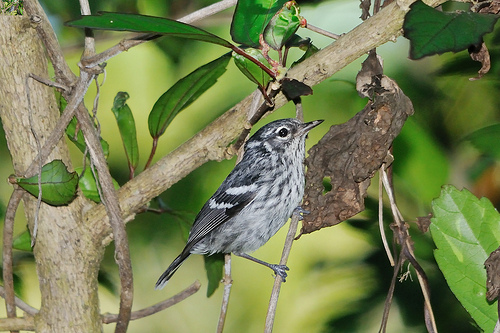It has been awhile since I have posted an entry in the Know Your Coffee Bird series, which profiles birds that utilize shade coffee farms. This post is about a species that was not on my short list for an upcoming account, but has a very special, recently defined connection to coffee.
The Elfin-woods Warbler (Setophaga angelae) is one of over 100 species of warblers found in the New World, and is only found in Puerto Rico. Discovered and described less than 50 years ago, it is named for a unique habitat it favors — elfin woods. High humidity and rainfall, strong winds, and nutrient-poor soils result in the short, often twisted trees (dominated by only a few species) that are characteristic of these forests, found between 750-850 meters. More recently, the warbler has also adapted to lower wet forests at 600-900 meters. This bird may have eluded discovery for so long due to being very similar in appearance to another species I have profiled as a coffee bird, the Black-and-white Warbler, which nests in North America but winters in Puerto Rico.
The Elfin-woods Warbler was likely always rare, and it was proposed for listing under the Endangered Species Act in 1982. Habitat loss and degradation due to development, agriculture, and hurricanes are among the factors that drove population declines in the following decades. The current estimate is fewer than 2000 individuals in two populations: in the El Yunque National Forest in the eastern part of the island, and in Maricao Commonwealth Forest and adjacent private lands in the west. Part of the latter is an Important Bird Area designated by BirdLife International.
Earlier this month, after years of languishing as a candidate, the warbler was finally designated as Threatened under the Endangered Species Act.
When a species is afforded protected status under the Act, “critical habitat” is designated. These are areas that are essential to conservation and which may require special management efforts. Critical habitat for the Elfin-woods Warbler is largely public land, but does contain private holdings including coffee farms and potential coffee-growing land adjacent to the Maricao Commonwealth Forest. The warblers have been detected in shade coffee plantations, but not in sun coffee farms. Thus, in the critical habitat areas, conversion of shade coffee to sun coffee will be prohibited. Conversely, the planting of shade trees on sun coffee farms is encouraged. Provisions for coffee growers in this area also allow for pruning of shade and coffee trees, but only outside of the nesting season. Herbicides and pesticides may be used, but only during the first two years or so while the coffee and shade trees are becoming established (a time in which the warblers are not likely to use the farm).
Previous research has indicated that much of Puerto Rico’s coffee is not grown under shade, but that farmers are willing to convert to shade if they were encouraged to do so by incentives such as being supplied with shade trees to plant. Since 2010, the US Fish and Wildlife Service has been working on habitat restoration initiatives in the Maricao coffee growing area through the Partners for Fish and Wildlife program. This has included technical and financial assistance to landowners to establish and restore shade coffee. The listing of the Elfin-woods Warbler will likely provide more incentive and opportunity for farmers to create and enhance shade coffee, to the benefit of this interesting bird and other biodiversity associated with its habitats.
Read more:
- Birdwatching Magazine: Elfin-woods Warbler added to endangered species list
- Courthouse News Service: Warbler’s listing cuts coffee growers a break
- Federal Register: USFWS ruling and details on listing
- Federal Register: Portion of ruling that outlines measures impacting coffee farms
- USDA Natural Resources Conservation Service: Info on initiatives to provide aid to coffee farmers to plant shade trees
- Cafiesencia: Puerto Rican non-profit with many rural community projects, often focusing on coffee-growing communities; projects include assisting landowners with forest management plans in the Maricao area for the benefit of birds, biodiversity, and farmers.
{ Comments on this entry are closed }
Revised on January 7, 2022



